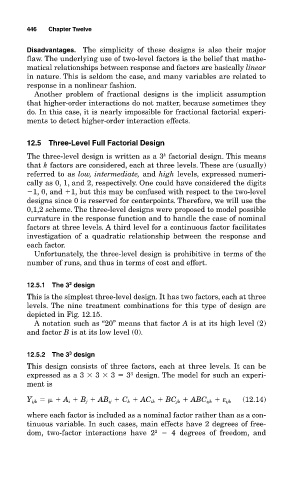Page 487 - Design for Six Sigma a Roadmap for Product Development
P. 487
446 Chapter Twelve
Disadvantages. The simplicity of these designs is also their major
flaw. The underlying use of two-level factors is the belief that mathe-
matical relationships between response and factors are basically linear
in nature. This is seldom the case, and many variables are related to
response in a nonlinear fashion.
Another problem of fractional designs is the implicit assumption
that higher-order interactions do not matter, because sometimes they
do. In this case, it is nearly impossible for fractional factorial experi-
ments to detect higher-order interaction effects.
12.5 Three-Level Full Factorial Design
k
The three-level design is written as a 3 factorial design. This means
that k factors are considered, each at three levels. These are (usually)
referred to as low, intermediate, and high levels, expressed numeri-
cally as 0, 1, and 2, respectively. One could have considered the digits
1, 0, and 1, but this may be confused with respect to the two-level
designs since 0 is reserved for centerpoints. Therefore, we will use the
0,1,2 scheme. The three-level designs were proposed to model possible
curvature in the response function and to handle the case of nominal
factors at three levels. A third level for a continuous factor facilitates
investigation of a quadratic relationship between the response and
each factor.
Unfortunately, the three-level design is prohibitive in terms of the
number of runs, and thus in terms of cost and effort.
2
12.5.1 The 3 design
This is the simplest three-level design. It has two factors, each at three
levels. The nine treatment combinations for this type of design are
depicted in Fig. 12.15.
A notation such as “20” means that factor A is at its high level (2)
and factor B is at its low level (0).
3
12.5.2 The 3 design
This design consists of three factors, each at three levels. It can be
expressed as a 3
3
3 3 design. The model for such an experi-
3
ment is
(12.14)
Y ijk A i B j AB ij C k AC ik BC jk ABC ijk ε ijk
where each factor is included as a nominal factor rather than as a con-
tinuous variable. In such cases, main effects have 2 degrees of free-
dom, two-factor interactions have 2 4 degrees of freedom, and
2

